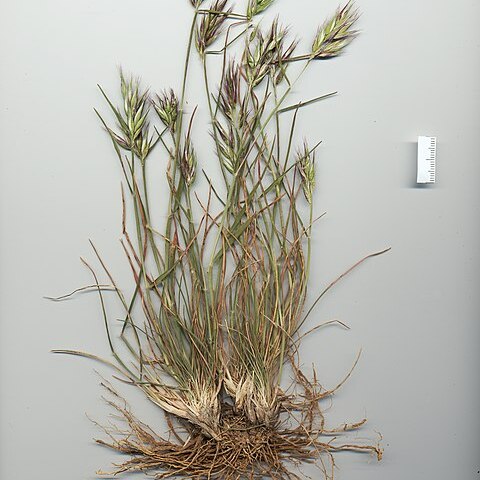Small, grey-green, hoary, stiff tufts, shortly rhizomatous; leaves < culms; branching intravaginal, shoots crowded, ± swollen at base. Leaf-sheath pale stramineous, light purple above, scattered long hairs increasing towards collar, culm sheaths especially hairy; apical tuft of hairs 1.5-3 mm, extending dorsally below blade. Ligule 0.4-0.5 mm. Leaf-blade to 5 cm, densely and conspicuously covered in long stiff hairs, inrolled with thickened sparsely scabrid margins, tip obtuse. Culm to 15 cm, internodes glabrous but long-hairy below inflorescence. Panicle small, compact, erect, to 2 cm of few large spikelets on short pedicels; rachis and pedicels conspicuously clothed in long stiff hairs. Spikelets (4)-6-8-flowered, awns exserted from glumes. Glumes irregularly purple-tinged, lanceolate, subobtuse, ± equal, (7.5)-9.5-13 mm; lower 11-13-nerved, upper 9-11-nerved. Lemma (2.2)-2.8-3.0 mm, 9-nerved, upper and lower row of hairs very dense, continuous, upper row < lemma lobes, lower row overlapping upper, glabrous elsewhere; lobes (6)-8-10 mm, tapering to strong awns ≤ central awn, lobes with a short (0.3-0.4 mm) acute membranous subsidiary lobe, adaxially tufts of hairs near base of awn sinus; central awn (6.5)-9-12 mm, column c. 3 mm ≤ upper lemma hairs. Palea (2.2)-3-3.4 mm, broad, apex rounded, < upper lemma hairs, interkeel hairs short, scattered, margins with longer fine hairs. Callus 0.4-0.7 mm, marginal hair tufts just reaching lower lemma hairs. Rachilla 0.2-0.3 mm. Anthers 0.3-0.4 mm. Caryopsis c. 1.5 × 1 mm; embryo 0.7 mm; hilum 0.4 mm.
More
Plants caespitose, with base frequently coarse; innovation buds intravaginal. Culms 13–70 cm high. Inflorescences obliquely ovate, almost capitate. Spikelets 12–16 mm long, with 5–7 florets. Glumes slightly exceeding florets; lower glume 11–16 mm long, c. 4.7 mm wide. Lemma: body 2.5–3.5 mm long, with margins auriculate near insertion of lobes, glabrous between the rows of tufts; both rows of hair tufts complete, with lower row exceeding upper row; lobes as long as body; setae 5–7.5 mm long, longer than lobes; awn 11–15 mm long, slightly exceeding setae; awn column tightly twisted, equalling lobes. Palea obovate, 3.1–4.4 mm long, broad, 1–3 times as long as wide, slightly exceeding lemma sinus, villous between keels. Anthers 0.45–1.7 mm long. Caryopsis 1.5–1.52 mm long.

